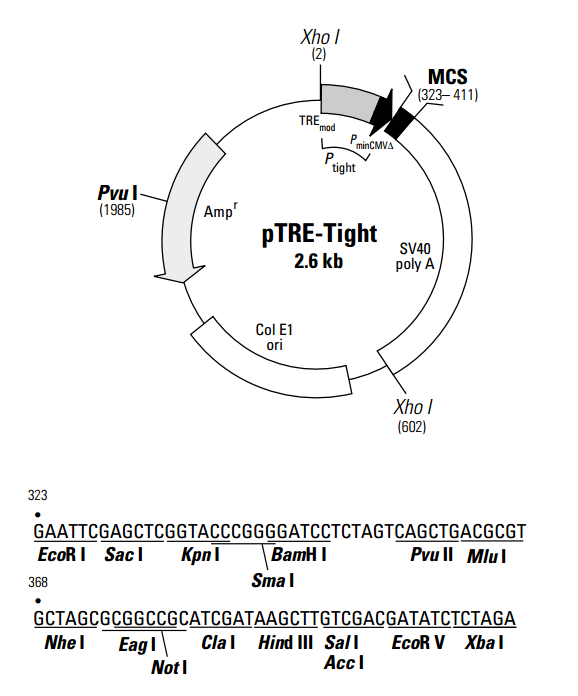pTRE-Tight 载体
pTRE-Tight is a response plasmid that can be used to express a gene of interest (Gene X) in our BD™ Tet-On and BD™ Tet-Off Gene Expression Systems and Cell Lines (1). The Tet Expression Systems and Cell Lines give researchers ready access to the tetracycline-regulated expression systems described by Gossen & Bujard (2; Tet-Off) and Gossen et al. (3; Tet-On). pTRE-Tight contains an MCS immediately downstream of the Tet-responsive Ptight promoter. cDNAs or genes inserted into the MCS will be responsive to the tTA and rtTA regulatory proteins in the Tet-Off and Tet-On systems, respectively. Ptight contains a modified Tet response element (TREmod), which consists of seven direct repeats of a 36-bp sequence that contains the 19-bp tet operator sequence (tetO). The TREmod is just upstream of the minimal CMV promoter (PminCMV), which lacks the enhancer that is part of the complete CMV promoter. Consequently, Ptight is silent in the absence of binding of TetR or rTetR to the tetOsequences. Note that the cloned insert must have an initiating ATG codon. In some cases, addition of a Kozak consensus ribosome binding site (4) may improve expression levels; however, many cDNAs have been efficiently expressed in Tet systems without the addition of a Kozak sequence. pTRE-Tight-Gene X plasmids should be cotransfected with the Linear Hygromycin Marker (#631625 or #6202-1, not included) or Linear Puromycin Marker (#631626 or #6203-1, not included) to permit selection of stable transfectants. pTRE-Tight was derived from pTRE, originally described as pUHD10-3 in reference 5.
The pTRE-Tight-Luc Control Vector, packaged with the pTRE-Tight Vector, contains an additional 1,649 bp encoding firefly luciferase inserted into the MCS. This vector can be used as a reporter of induction efficiency using standard luciferase detection reagents. It is not intended as a cloning vector.


